Before becoming an important tourist destination, Marrakech was a significant fortress used as a safe haven for caravans coming from the desert. As there were no longer any overseers to know the intentions of the refugees, the historical gates of Marrakech were built. Historians differ on the exact date of the construction of the city walls, but most of them believe it took place between 1126 and 1127 AD. The length of these defensive walls is estimated to be around nine kilometers, all built with compacted earth, locally known as “al-lauh.”Marrakech, a city in Morocco, is known for its historical gates.

There are major original gates of the Marrakesh fortifications, in linear sequence, they are:
Gates named after the intended destination: Bab Fes (also known as Bab Al-Khemis), Bab Nfis.
Gates named after the people who arrived in Marrakech: Bab Agmat, Bab Aylen, Bab Ahmar.
Internal gates named after their residents, roles, neighborhoods, crafts, or paths: Bab Ad-Drab, Bab Ahmar, Bab Ad-Dabbagh, Bab Ad-Dar, Bab As-Suq.
Other gates with general meanings: Bab Agmat, Bab Taghzout, Bab Al-Khemis (or Bab Fes), Bab Aknaw, Bab Dkala, Bab Ar-Rob, Bab Hailana (or Bab Aylen).
Some of the best historical gates of Marrakech that are recommended to visit are Agnaou Gate, Bab Doukkala Gate, Bab Er-Robb Gate and Bab Eddabaguines (tanners) Gate.
These gates have their own unique history and architecture. For example, the Agnaou door is an internal door that separates the royal kasbah from the rest of the city and was built in the 12th century in the era of the Almohad Caliph Abd al-Mumin bin Ali al-Koumi. The Doukkala Gate is among the main doors of the ancient city walls of Marrakesh and is formed by two large towers with a corridor leading to the center of the ancient city.
Bab Dkala:
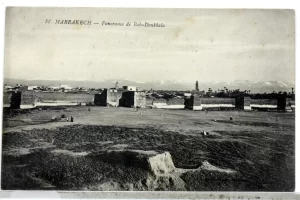
Regarding Bab Dkala, it is formed by two large towers with a passage in between that leads to the heart of the old city. The name “Dkala” is derived from the nearby area surrounding the city, which was inhabited by the Almohad population.
Bab Dkala is considered one of the main gates within the ancient walls of Marrakech. It is situated on the western side and leads to the Bab Dkala Mosque. The gate is formed by two large towers with a passage that leads to the heart of the old city, connecting to Lakza Road and Ayheri Arset from one side and through Suwayqa Bab Dkala and its grand mosque from another side.
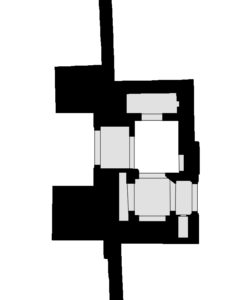
The name “Dkala” reflects the direction of caravans towa
rds the plains of Dkala and the Chaouia region, which were inhabited by the commercial population at that time.

Bab Agmat:
As for Bab Agmat, it is one of the gateways formed by one of the towers that punctuate the eastern side of the city walls.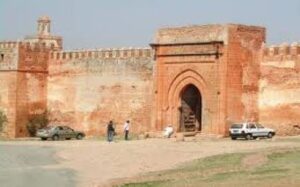
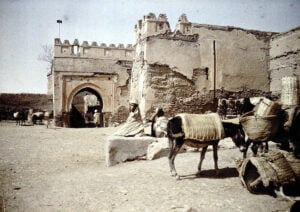
This gate consists of two large and ancient arches that have witnessed several eras, historical events, and changes. It is located in the Sidi Youssef ben Ali neighborhood, an old neighborhood that is surrounded by a very vast cemetery. It is close to the Rabia Souk and Bouskri areas. Bab Agmat opens on the eastern side of the old city, on the road leading to the corner of Sidi Ben Saleh, and then to the tribes of the southeastern region of Marrakech. On the other side, there is another Bab Agmat located in the eastern part of the old city, opening onto the road leading to the Bab Aylen and Bouskri neighborhoods and the corner of Sidi Mohammed ben Saleh.
In summary, Bab Agmat is one of the gateways formed by the towers along the eastern side of the city walls.
Bab Agnaou:
Among the gates that the Almohads used to fortify the Kasbah of Marrakech with, several of them have disappeared, except for Bab Agnaou, which still stands proudly in front of the minaret of the mosque.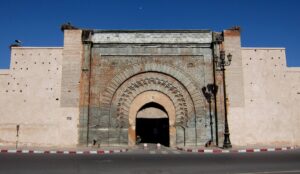 It is the main gate of the Almohad Kasbah, distinguished by its beautiful design and unique architecture. It bears the Amazigh name “Agnaou,” which translates to “the mute” in Arabic, with the letter “Kaf” pronounced as “Jim” in the Egyptian accent.
It is the main gate of the Almohad Kasbah, distinguished by its beautiful design and unique architecture. It bears the Amazigh name “Agnaou,” which translates to “the mute” in Arabic, with the letter “Kaf” pronounced as “Jim” in the Egyptian accent.
Moroccans use the term “Agnaou” to refer to African elements with incomprehensible speech, saying in Amazigh: “Arisawal S’taknaout,” meaning “speaks in an incomprehensible Kanawi (Amazigh) language.” Despite being an internal gate that separates the Kasbah or royal quarter from the rest of the city, Bab Agnaou is a masterpiece among the historical gates of Marrakech.
It was established during the reign of the Almohad Sultan Abd al-Mu’min ibn Ali al-Kumi. It has been restored during the time of the Marinids and later by the French architect Charles Boccara in the early 20th century. It was also featured on Moroccan banknotes during the reign of King Mohammed V, who was the ruler of the country at that time.
Bab Ar-Rob:
Bab Ar-Rob is one of the historical gates of Marrakech, and it derives its name from “Ar-Rob,” a type of beverage that was consumed by the people of Morocco in ancient times. This drink was extracted from grapes and was known to be widespread during the Almohad era.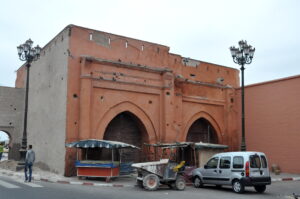
Its origins trace back to the Dyrn Mountains, which are part of the High Atlas range. The people of Dyrn used to drink it to endure the extreme cold and snow of the mountains. Bab Ar-Rob was one of the beverages served during official ceremonies and events. The Almohad Caliph Abu Ya’qub al-Mansur presented it to the attendees during one of his gatherings at Lake of Bahir Marrakech, where people were offered this drink for 15 days. The number of daily visitors exceeded 3000 people.
According to the book “Lisan al-Arab,” Ar-Rob refers to a thick and dark liquid, or it could also mean the juice of any fruit after the fermentation and boiling process.
In Spanish dictionaries, the word “Arrope” has a similar meaning, referring to local juice, which could be from dates or figs.
Bab Ad-Dabbaghin:
Bab Ad-Dabbaghin is one of the historical gates of Marrakech and is considered one of the oldest historical gates in the city, dating back to the Almoravid era. 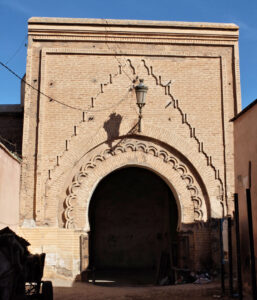 Despite undergoing various restoration processes over the decades and centuries, it still retains its historical charm and cultural and touristic significance.
Despite undergoing various restoration processes over the decades and centuries, it still retains its historical charm and cultural and touristic significance.
Bab Ash-Shari’a:
Bab Ash-Shari’a is also one of the historical gates of Marrakech, and it belongs to the Almoravid architecture. Unfortunately, it was demolished on Monday, the 25th of Rabi’ al-Thani, 579 AH, corresponding to the 17th of August 1153 CE, for reasons that remain unknown.
Bab Fes (also known as Bab Al-Khemis):
Bab Fes is one of the historical gates of Marrakech, and it is sometimes referred to as “Bab Al-Khemis.” It has been known by this name since the Saadian period. It is one of the first gates built in the Marrakech city walls and dates back to the time of the wall’s construction. Bab Fes still stands in its original form and is located in the eastern part of the northern facade of the ancient Marrakech city walls.
Bab Al-Khemis (also known as Bab Al-Juma’a):
Bab Al-Khemis is one of the historical gates of Marrakech. It was previously called Bab Fes until the Marinid era between the 13th and 15th centuries when it was named Bab Abi Al-Abbas As-Sabti during that period. The gate was originally constructed during the Almoravid dynasty’s rule (1056-1147 AD).
In the year 1802, during the reign of Sultan Moulay Slimane Alawi, the gate underwent renovations. Bab Al-Khemis holds historical significance as it witnessed a confrontation between the Moroccans and the Portuguese. The Portuguese had reached this gate during their incursion from the port of Essaouira with the intention of advancing into the capital city of Morocco. However, they were defeated by a swift maneuver of Moroccan knights on April 23, 1515 AD.
Bab As-Salihah:
Bab As-Salihah is one of the oldest gates in the ancient walls of Marrakech. It is said to have been built during the construction of the city walls and remained intact throughout the Middle Ages. It was named after Lady Bahira As-Salihah, whose shrine is located in the southern part of the Almoravid city. The area was later replaced by the Salihah neighborhood during the rule of Caliph Abu Ya’qub Yusuf.
Bab Al-Kuhl:
Bab Al-Kuhl is located in the northwestern corner of the Kasbah.
Bab As-Sadah:
Bab As-Sadah is located on the western facade of the Kasbah’s walls.
Bab Al-Bustan:
Bab Al-Bustan is situated on the southern facade of the Kasbah’s walls.
Bab Al-Makhzen:
The history of Bab Al-Makhzen dates back to the construction of the old Marrakech walls. It still features its entrance and remnants of towers on the right and left. Historians believe that the present-day Bab Al-Ahmar is the location of Bab Al-Makhzen. Bab Al-Makhzen was a historical gate during the Marinid era. The name refers to the government’s headquarters in the eastern regions, indicating the central state since the unification of Moroccan territory under the reign of Sultan Yusef ibn Tashfin Almaituni Almoravid.
Bab Al-Ahmar:
Bab Al-Ahmar is located in the northwestern corner of the Kasbah. It was called Bab Al-Ahmar due to its location near the route leading to the Ouled Ahmar tribe. This gate was outside the Almoravid walls and was built during the 18th century. It was part of the green area known as Bahira As-Salihah during the Marinid rule. Bab Al-Ahmar is a recent construction, dating back to the 18th century, and served as an external exit for a neighborhood where black servants of the government lived.




